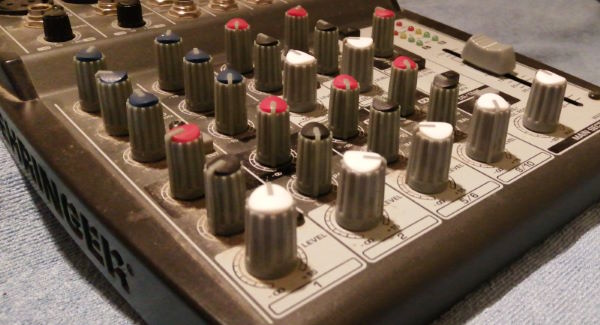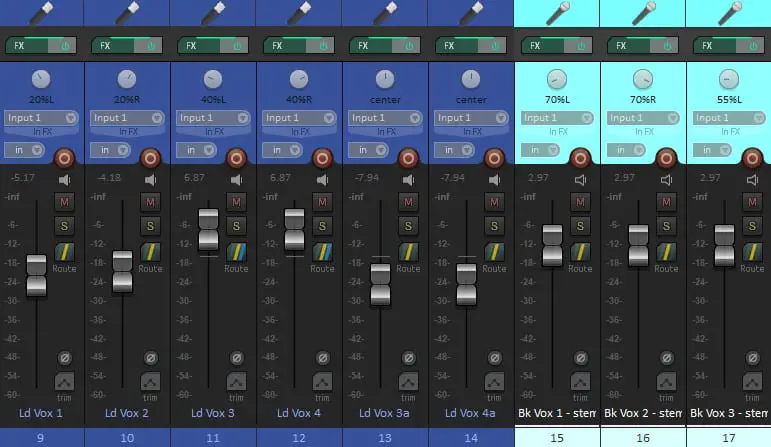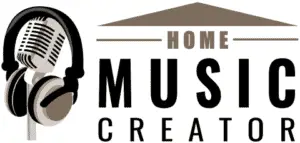Mixing and mastering are vital steps in the music production process, yet are often thought of as the most difficult. I struggled with mixing and mastering for years, and even though the principles behind them are fairly simple, why do so many novices find them so challenging?
Mixing and mastering are difficult because it can take years to train your ears to identify and focus on specific frequency ranges. It takes even longer to recognize how to fix a problem with a frequency, and what actions to take to bring forward or push back a particular element of your mix.
There are many elements to mixing, and each one can take a long time to learn. Then when you throw them together the potential for confusion is immense! Add mastering on top of this where you need to be highly skilled in identifying problem frequencies, compression and limiting, there is a huge amount to learn and practice.
Let’s break down these reasons for difficulties in mixing and mastering, and what we may be able to do about them.
If you are interested in checking out the best recording gear such as audio interfaces, studio monitor speakers, microphones, etc., you can find them at Amazon by clicking here.

Mixing difficulties and how to overcome them
Much like learning a musical instrument, it can take years and years to get proficient in mixing. I have been playing the piano for 40 years, and there is still a lot I want to learn. So don’t expect your first efforts in mixing to be as good as a professional who has been doing it for years.
You won’t be surprised to learn that the key is practice, practice, practice. Mix lots of songs, be prepared for the results to be pretty bad, but resolve to learn something from each mix and get just a little bit better on the next one.
These are the main elements in mixing….
- Gain staging
- Level balancing
- EQ
- Compression
- Panning
- Ambiance (reverb, delay, etc)
Focus on getting good at each element one at a time, so you start from a good base when you come to learn the next one. For example, if your levels are not balanced well, then it’s likely you are going to have great difficulty when it comes to EQ’ing your tracks in the mix.
As a beginner mixer, there is so much to learn it can be difficult to know where to start. If that sounds like you, then definitely check out my “mixing – where to start” article. It is a comprehensive mixing guide for complete beginners. It takes you step-by-step through making your first mix, and breaks the mixing process down into easily manageable and understandable tasks.
Gain Staging
Gain staging is making all your tracks the same volume when the faders are in their default 0dB positions. This is important, as it gives you the same amount of room to raise or lower the volume for all your tracks. Say, for example, one of your tracks is quieter than the others and you have to move the fader right to the top to make it the same volume as the other tracks. You now have no room to increase it should you need to during the mixing process.
Learn how to change the volume of your tracks without using the fader. This may be by…
- Increasing the gain on a track
- Turning up the volume in a virtual instrument
- Using a volume plugin
Then practice getting all your tracks at the same level, without moving any faders from their default 0dB positions.
Level Balancing
Once the tracks are all a similar volume, practice using the faders to balance out their relative volumes. This is a personal taste thing to an extent, but dependent on the style of track.
To help here, listen to commercial tracks similar to your track in your genre, to get an idea of how loud each instrument is in relation to each other, which instruments are at the front of the mix, which are pushed back, etc.
EQ
Learning to EQ properly is the hardest part of mixing
In my opinion, learning to EQ properly is the hardest part of mixing.
Learn which frequencies are present in which instruments, and which frequencies are not. Practice common EQ moves such as using High and Low Pass Filters, adding high end sparkle at around 6kHz, applying a cut at around 400Hz, to see what effect these have.
These “numbers” (6kHz, 400Hz, etc) used in EQ are often a source of great confusion for beginners. If you are confused, then definitely check out this guide to what EQ numbers actually mean. It will teach you to understand and use those numbers in a clear and simple way.
Then just practice you heart out! Remember EQ is an incredible tool, but with great power comes great responsibility – EQ can just as easily destroy a mix as enhance one. Try to lean towards subtle moves rather than huge cuts or boosts, especially when you’re a beginner.
It can take a long time to train your ears and mind so you can automatically focus on the frequencies you need to. Be patient, and accept that this is going to take a lot of time and a lot of practice.
Incorrect use of EQ can often be the cause of a mix sounding muffled, lifeless or dull. That’s why I wrote an article on how to prevent your mix sounding muffled. If you are an EQ novice, I highly recommend you check it out for tips on keeping your mix sounding alive and eliminating dullness using EQ.
Compression
Compression is reducing the volume difference between the loudest and the quietest sounds. This can make sure that a track level is more even, that quieter sections can be heard and that louder sections don’t overpower a track.
Learn about the different controls on a compressor – threshold, ratio, attack and release – and how they affect the sound. Practice playing around with these to get a good feel for what they do.
Panning
Learning where to put your instruments in the stereo space is an important skill. Again, listening to commercial tracks can be a great help. Learn what the common practices are for music in your genre, and begin by using those. Once you have got used to that you can begin to get a little creative, but be careful not to stray too far from the norm otherwise you are likely to shock listeners to that genre.
Ambience
Adding reverb or delay to your mix can make a huge difference to the atmosphere of your track. But be careful not to overdo it – you can easily wash out a great mix with reverb, losing all the clarity and definition you have carefully crafted.
Listen to similar commercial tracks to yours to see what type of reverb, how much to use, and where to apply it as a starting point for your track. Learn how to create a “reverb bus” and send multiple tracks to it, so that different instruments can use the same reverb. This can make several instruments sound like they were recorded in the same room.
Learn which instruments benefit from reverb or delay and which don’t. For example, a bass guitar in a rock track is unlikely to have much reverb on it, whereas a lead guitar part is much more likely to.

When you are first starting mixing, it is difficult to know what you should be aiming for to get a good mix. Check out my “What makes a good mix?” article for tips on what you should be listening out for and working towards when mixing to get the best sounding mix possible.
Mastering difficulties and how to overcome them
Mastering used to be preparing your tracks to get onto vinyl. This is a highly skilled process that is still done today, but for us mastering most likely means preparing your tracks to be released on digital platforms such as Spotify, Amazon Music, iTunes, Deezer, etc.
This can include…
- Making sure all tracks in an album sound similar (volume, frequency response)
- Bringing the volume up to the required level
- EQ (usually very subtle at the mastering stage)
Learn to use a limiter to bring up the volume up to a certain point. This is so your tracks will be just as loud as other tracks played on digital services or the radio.
Practice listening to commercial tracks and identifying frequencies that could be slightly cut or boosted in your track to make them sound similar. This is a very difficult skill, and is something that will most likely take years to become good at.
Use automated web mastering tools such as BandLab, CloudBounce or Landr. Compare the results of these with your own mastering efforts, and see if you can identify what they did and replicate them.
When you are first starting out in music production, it can be tempted to wonder what exactly the point of mixing and mastering is. This article on “Why mixing and mastering are so important” goes through why exactly they are needed, and should clear up any confusion you might have as to what their purpose is.
Using reference tracks
You have probably noticed a theme in all the above; listening to similar commercial tracks and try to reproduce what they do.
Using reference tracks is a take on this theme. You would typically bring a commercial track into your DAW, set the volume level so it’s a similar volume as your track, and try to make your track sound like the reference.
This can be a very useful technique. However I don’t recommended this when first starting out, as it can be distracting and discouraging and make you try to focus on too many things at once.
Concentrate on one aspect of mixing to start with, and focus on getting comfortable with that.
Don’t rely on presets
EQs, compressors, reverbs, delays, etc. all have multiple presets built into them.
These can be great starting points, but are rarely the optimum settings for your own mix – every mix is different and there isn’t just one magic setting that will automatically mix your song for you. You also will never learn anything if all you do is set a preset, then move on.
By all means use a preset as a starting point, but then modify the settings as befits your mix using your ears, taste and common practice in your song’s genre.
How long does it take to learn mixing and mastering?
You can learn the technical basics of mixing and mastering in a few days. However, to become an expert takes years of practice mixing and mastering many songs. Your ears need time to be trained to focus on the different frequencies and tonal properties required for true proficiency.
For more details, check out my comprehensive article on how long it takes to learn mixing and mastering. It gives you realistic timescales on getting to various different levels of proficiency with mixing & mastering, and breaks down the key skills you will need and how long each will take to develop.
Here is some of my favorite home studio gear…
Thanks for reading this article. I hope you found it helpful in your home music-making activities. Here are a few of the tools that I personally use in my home studio. These are affiliate links, so if you decide to use any of them I’ll earn a small commission.
Audio interface: My personal choice for audio interfaces are the Focusrite Scarlett series. I have been using these for years, and they have always given me great-sounding recordings. For a very reasonable price from Amazon you can buy the excellent Focusrite Scarlett 4i4, or if you don’t need MIDI capability the Focusrite Solo is a great choice.
Amp sim: Guitar amplifier simulator software has come on leaps and bounds in recent years, such that I record all my electric guitar parts using amp sims these days. One of the very best is the incredible Amplitube from IK Multimedia, which I have used on many of my songs.
Headphones for recording: My favorite headphones for recording are the Sony MDR-7506s, which I use for monitoring during all my recording sessions. They can also be found in many pro recording studios. Get the Sony MDR-7506 headphones from Amazon here.
General-purpose microphone: You can’t go wrong with a good ol’ Shure SM-57, one of the most versatile and ubiquitous microphones around. I’ve been using one in my home studio for as long as I can remember. Amazon offers the Shure SM-57 for a very competitive price.
To see all of my most up-to-date recommendations, check out this resource I made for you!

